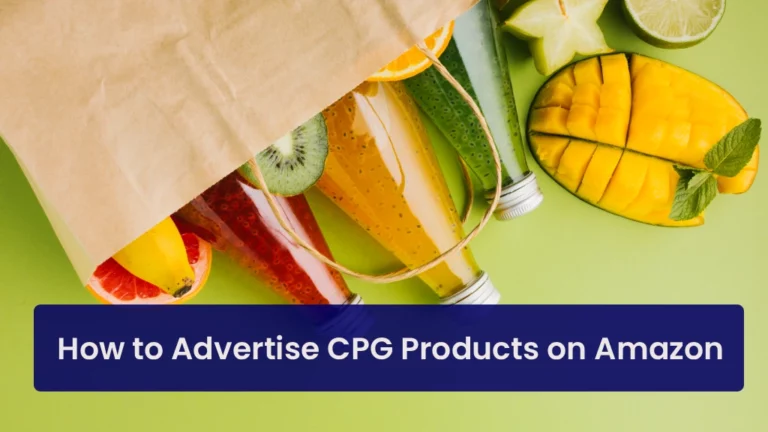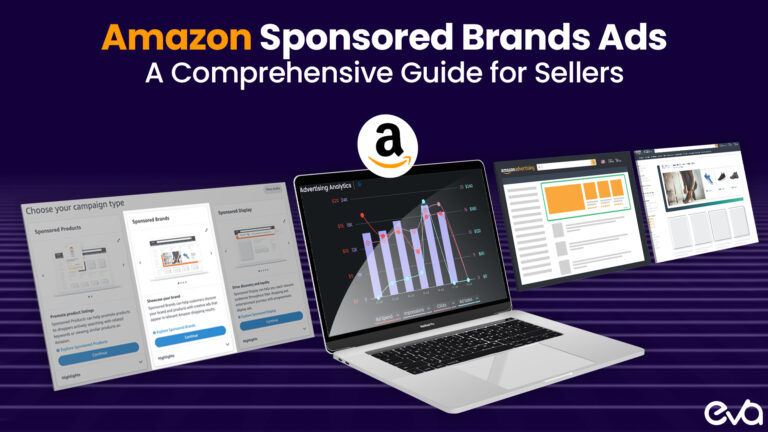Transform your Amazon PPC advertising by focusing on what NOT to target—the secret strategy of 7-figure sellers
In the increasingly competitive Amazon advertising landscape, success often comes not just from what you target, but what you deliberately exclude. Negative keywords have emerged as one of the most powerful yet underutilized tools for optimizing your Amazon advertising campaigns.
This comprehensive guide will walk you through implementing an effective negative keyword strategy that can dramatically improve your advertising efficiency and profitability.
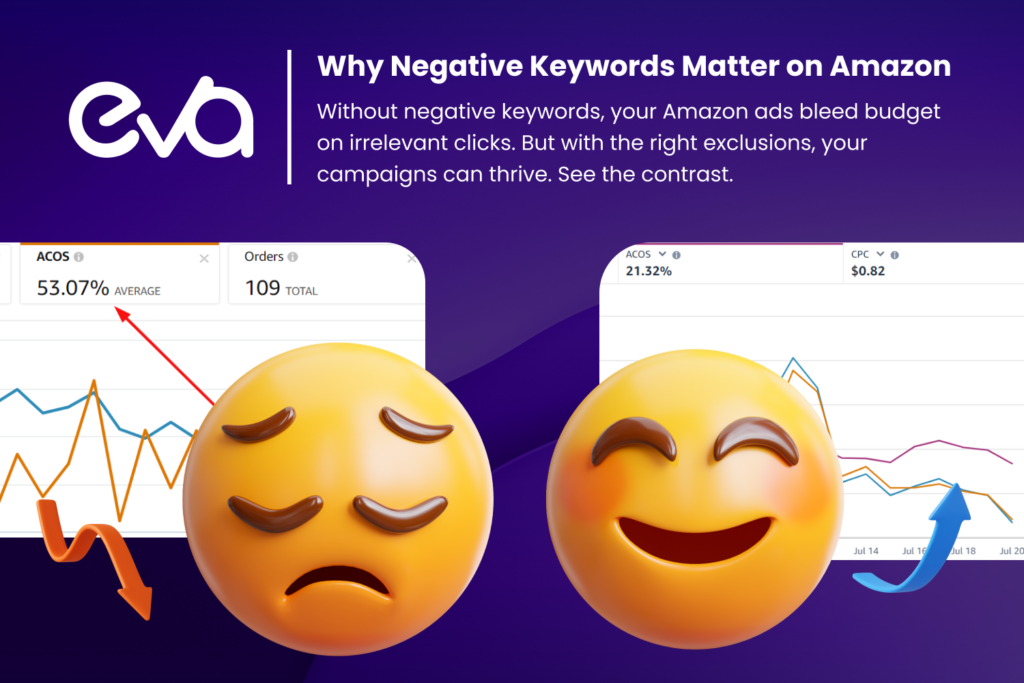
Table of Contents
- Understanding the Critical Role of Negative Keywords
- Systematic Methods to Identify Valuable Negative Keywords
- Strategic Segmentation by Match Type
- Strategic Implementation Across Campaign Structure
- Continuous Optimization Approaches
- Advanced Techniques for Experienced Sellers
- Scaling Your Negative Keyword Management with Eva
Understanding the Critical Role of Negative Keywords
Negative keywords are search terms that prevent your ads from appearing in searches when shoppers use those specific queries. While this concept might seem simple, their strategic implementation can transform your advertising performance.
Key Benefits of a Robust Negative Keyword Strategy
Elimination of Wasted Ad Spend: By preventing your ads from appearing for irrelevant searches, you avoid paying for clicks that have virtually no chance of converting. For most sellers, this alone can reduce wasted spend by 15-30%.
Improved Click-Through Rate (CTR): When your ads only appear for relevant searches, CTR naturally increases. Higher CTR signals to Amazon’s algorithm that your ads are relevant, potentially improving your quality score and lowering your keyword bids over time.
Lower Advertising Cost of Sale (ACoS): Focusing your budget on searches with genuine purchase intent will result in more conversions for the same ad spend, driving down your overall ACoS.
Enhanced Campaign Control: Negative keywords give you greater precision in directing traffic between different ad campaigns and ad groups, reducing internal competition and creating more structured account architecture.
Systematic Methods to Identify Valuable Negative Keywords
Effective negative keyword identification requires a methodical approach combining multiple data sources and analysis techniques.
Search Term Report Analysis
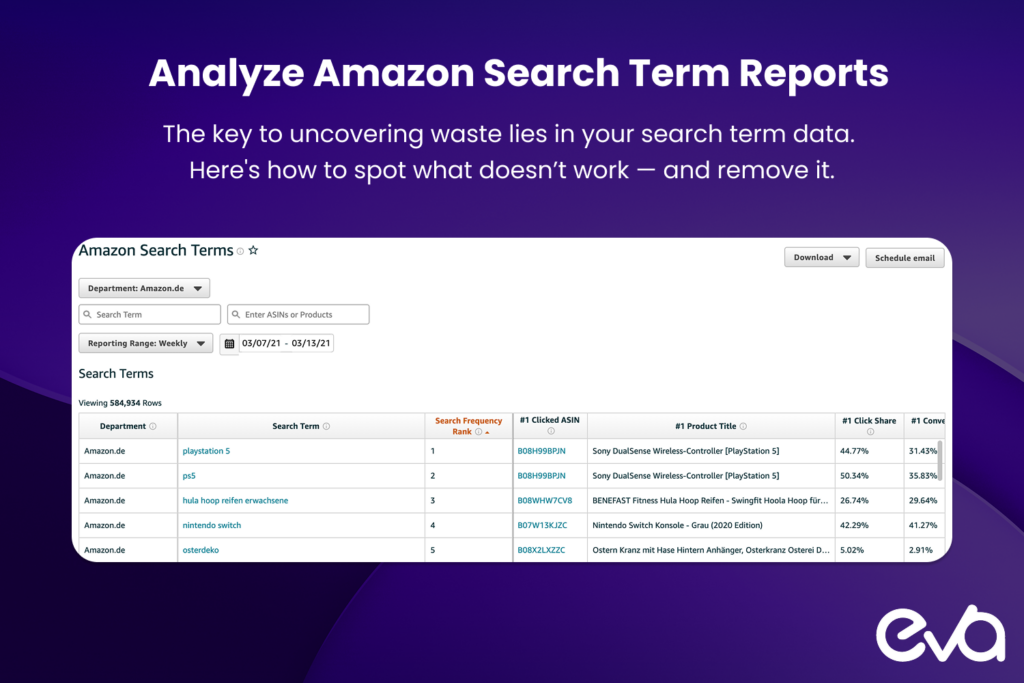
The foundation of any negative keyword strategy begins with your search term reports in Amazon Seller Central. Review these reports regularly, looking for:
- Terms with high spend but no conversions (typically any term with >5 clicks and no sales)
- Queries with extremely low click-through rates (<0.2%)
- Searches showing clicks but conversion rates significantly below your campaign average
- Irrelevant terms that shouldn’t be triggering your ads at all
Advanced sellers use N-gram analysis to identify patterns in non-converting search terms. This technique breaks down search queries into common word combinations, revealing problematic word patterns that might not be obvious when looking at individual terms.
Customer Intent Filtering
Not all relevant search terms have the same purchase intent. Create negative keyword lists for terms indicating:
- Research Phase: Terms like “how to,” “guide,” or “comparison” often indicate shoppers in research mode rather than ready to purchase
- DIY Alternatives: Queries containing “DIY,” “homemade,” or “alternatives to” suggest users looking to avoid purchasing
- Price Sensitivity: Words like “cheap,” “discount,” “free,” or “lowest price” can indicate shoppers unlikely to convert at your price point
- Incompatible Use Cases: Terms suggesting use cases your product doesn’t support or isn’t designed for
Competitor Brand Protection
Create negative keyword lists for:
- Competitor brand names (unless you have a specific conquest strategy)
- Product lines you don’t compete with
- Accessories or components specific to competitor products
Manual Search Audits
While data-driven approaches are essential, nothing replaces occasional manual searches:
- Search for keywords related to your products
- Note where your ads appear for irrelevant queries
- Add these terms as negatives
- Repeat this process monthly to catch new search trends
Strategic Segmentation by Match Type
Understanding when to use each negative keyword match type is crucial for maintaining precision.
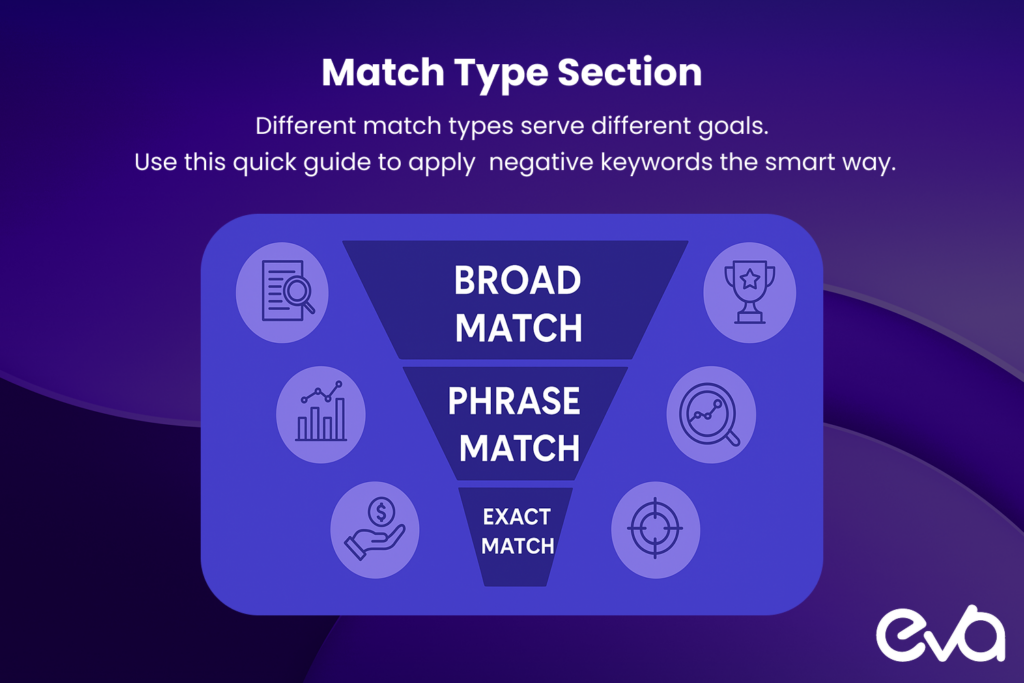
Negative Broad Match
This match type blocks your ads from appearing in searches when all the words in your negative keyword appear in a search query, regardless of order. Use negative broad match keyword strategies for:
- General categories you don’t want to target
- Words that have no relevance to your product in any context
For example, if you sell leather phone cases, you might add “plastic” as a negative broad match to avoid showing for plastic case searches.
Negative Phrase Match
This blocks queries containing the exact phrase in the specified order, even with additional words before or after. Use negative phrase match for:
- Specific phrases indicating different product types
- Common multi-word expressions with clear intent that doesn’t match your offering
For example, “for children” as a negative phrase match would prevent your ads from appearing in searches for “phone cases for children” if you don’t sell children’s products.
Negative Exact Match
This blocks only the exact search term in the precise order specified. Use negative exact match for:
- Very specific queries that don’t match your product but might share words with relevant searches
- High-volume irrelevant queries that need precise exclusion
For example, “iPhone 12 Pro Max case” as a negative exact match would block only that specific phone model case if you don’t offer it, while still allowing your ads to show for other iPhone case searches.
Strategic Implementation Across Campaign Structure
Where you apply negative keywords is just as important as which ones you choose.
Campaign-Level Implementation
Apply broader exclusions that affect all ad groups within a campaign:
- Competitor brand names
- Irrelevant product categories
- General terms indicating incompatible use cases
Ad Group-Level Precision
Use more targeted negative keywords at the ad group level to:
- Prevent overlap between ad groups targeting different product variations
- Create clean traffic segmentation between similar products
- Implement specific exclusions relevant only to particular products
Advanced Strategy: Negative Keyword Lists
Create reusable negative keyword lists for efficient management:
- Competitor List: All competitor brands and product lines
- Low-Intent List: Research-phase queries and low purchase intent indicators
- Product Specification List: Features or specifications your products don’t have
- Category Exclusion List: Related but irrelevant product categories
These lists can be applied to multiple campaigns simultaneously and updated centrally for efficient management.
Continuous Optimization Approaches
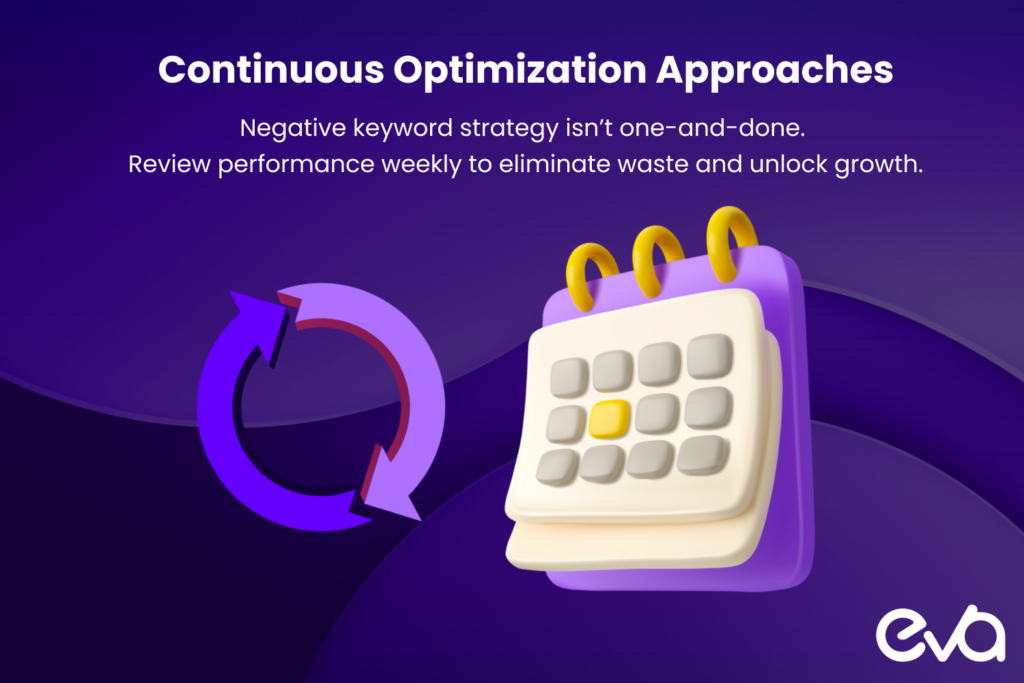
Negative keyword strategy isn’t a one-time setup but an ongoing refinement process.
Regular Performance Review
Schedule weekly or bi-weekly reviews of search term reports to identify:
- New non-converting terms to exclude
- Patterns in wasteful spend
- Changes in search behavior requiring strategy adjustments
Performance Metrics Monitoring
Track these critical metrics to ensure your negative keyword strategy is effective:
- Click-through rate trends before and after implementation
- Conversion rate changes across campaigns
- Overall ACoS improvement
- Impression-to-sale ratio
Avoiding Over-Restriction
While negative keywords are powerful, excessive exclusions can limit your reach. Watch for:
- Sudden drops in impression volume after adding negative keywords
- Declining overall traffic despite stable keyword bids
- Reduced visibility for previously high-performing search terms
If these occur, review your negative keywords for potential over-restriction.
Advanced Techniques for Experienced Sellers
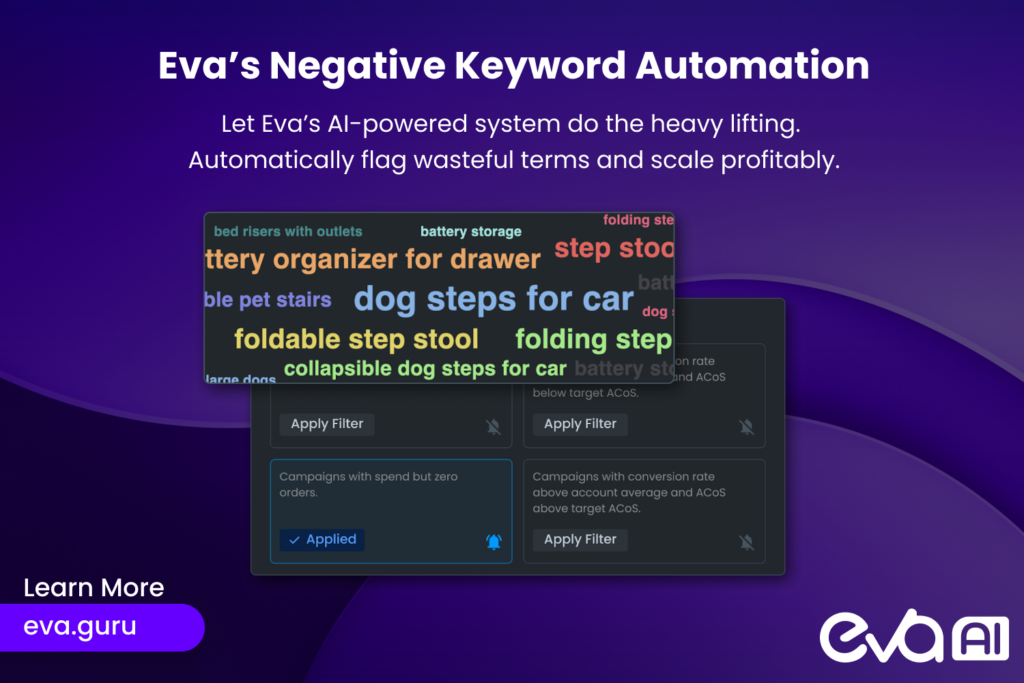
Once you’ve mastered the basics, these advanced approaches can further refine your strategy.
Negative Keyword Tiering
Instead of immediately excluding underperforming keywords, implement a tiered approach:
- Identify keywords with higher-than-target ACoS
- Reduce bids for these terms before excluding them completely
- Only add as negative keywords if performance doesn’t improve after bid adjustments
This maintains valuable traffic while improving profitability.
Search Query Sculpting
Use negative keywords to direct specific queries to their optimal campaigns:
- Add high-value branded terms as negatives in generic campaigns to force them into brand-specific campaigns
- Exclude category terms from product-specific campaigns to channel them to category campaigns
- Use negatives to prevent budget drain from your best-performing exact match campaigns
Automatic Campaign Refinement
An automatic campaign can be a valuable source of keyword discovery, but requires negative keyword management to maximize effectiveness:
- Start with broad keyword targeting in your automatic campaign
- Regularly transfer high-converting search terms to manual campaigns with optimized bids
- Add these same terms as negative keywords in the automatic campaign to prevent competition
- Let the automatic campaign continue discovering new opportunities
This creates a continuous cycle of keyword discovery, optimization, and refinement.
Scaling Your Negative Keyword Management with Eva
As your Amazon business grows, manual management of negative keywords becomes increasingly time-consuming and complex. Eva’s advanced Amazon advertising platform can help you implement sophisticated negative keyword strategies at scale.
Eva’s technology combines AI-driven analysis with expert human oversight to:
- Automatically identify non-converting search terms across your entire account
- Detect patterns in wasteful spend that might not be obvious in manual analysis
- Implement negative keywords strategically across your campaign structure
- Continuously monitor and adjust your strategy based on performance data
By partnering with Eva, sellers typically see a 20-35% reduction in wasted ad spend while maintaining or increasing overall sales volume. Our comprehensive approach to negative keyword management is just one component of our holistic Amazon advertising optimization service.
Ready to transform your Amazon advertising efficiency? Contact Eva today for a complimentary advertising audit that will identify specific opportunities to improve your negative keyword strategy and overall campaign performance.



